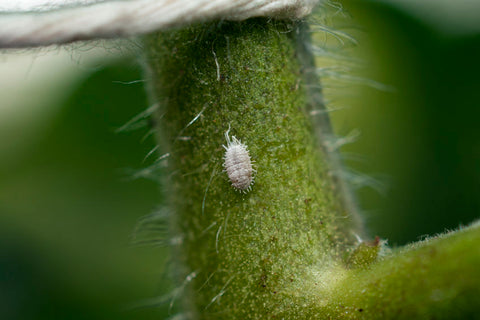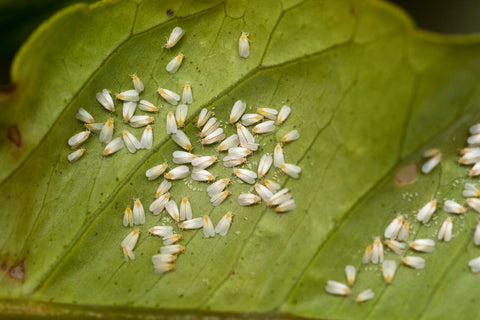Insect pests and plant diseases are unfortunately a part of the gardening experience. Knowing which pests are likely to attack your garden can help you prevent an infestation. Check out ten small pests that can wreak havoc on your plants and garden vegetables.
1. Aphids

Aphids are tiny, about 1/8" in length, and pear-shaped. They vary in color and can be yellow, green, red, brown, and black depending on the species. There are more than 4,000 known aphid species in existence. Aphids feed on plants, sucking the sap from them. They also produce a sticky substance called honeydew. Their honeydew can attract ants and produce a dark, sooty mold on plant leaves, which can hinder plant growth.
2. Fungus Gnats
Fungus gnats are typically associated with houseplants. Adult fungus gnats range in size from 1/16"–1/8". They have a gray or black body. Larvae are about 1/8". They thrive in damp soil in flowerpots and gardens. Adults aren’t harmful to plants, but their larvae can be a problem. These pests lay eggs near the surface of soil, and larvae live in the soil. They typically feed on fungi and decaying plant matter, but they will feed on plant roots too.
3. Fruit Flies

Fruit flies are typically found hanging around your kitchen in search of ripening fruit and vegetables. They can also be drawn to fallen or rotting produce in your garden. These pests are about 1/8". They have a tan or black body and large, red eyes. Adult fruit flies lay eggs on produce, and their larvae feed on the decaying produce. Removing fallen fruit and vegetables can help to keep these pests away.
4. Leafhoppers
Leafhoppers are wedge-shaped insects that measure about 1/4" in length. Leafhoppers can be green, brown, or yellow, and they have patterns on their bodies. These pests are known for flying away quickly and running sideways. Leafhoppers damage plants when they feed on the plant’s sap. Their feeding results in spotting and yellowing of leaves. They target fruit, vegetables, and flowers. Adults and nymphs can be problematic in gardens.
5. Scale Insects

Scale insects look like bumps on your plants. Scale insects are classified as soft or hard. Soft scale insects have a waxy film and grow to about ½". Hard scale insects have a hard shell and are about 1/8" in length. Soft scale insects move short distances, while hard scale insects are immobile. These pests suck sap from plants, which can lead to discoloration, deformation, and stunted leaf growth.
6. Leafminers
Leafminers tunnel through the leaf tissue of plants. The term can refer to a variety of insect larvae including flies, sawflies, and moths. Leafminers are wormlike and typically green or yellow. They live in and feed on the leaves of plants. Different leafminer species feed on different plants. Their feeding causes white lines or blotches on leaves. While this won’t affect the growth of the plant, it will destroy the edible leaves.
7. Mealybugs

Mealybugs are tiny, unarmored insects. These pests are related to scale insects. They are usually found in moist, warm environments. They are soft-bodied and fuzzy in appearance. Mealybugs grow between 1/10ʺ–1/4ʺ in length. These pests feed on the juices of plants and some trees. This can cause discoloration and curling of leaves. Mealybugs also secrete honeydew, which can promote mold growth.
8. Spider Mites
Spider mites are tiny pests that can be difficult to see. These arachnids are reddish-brown, but they will appear as red or dark specks on plants. They produce webs that are visible on the stems and leaves of plants. Spider mites feed on plants, which results in small spots. As they continue feeding, the area of discoloration will grow. You may also notice curled leaves. Spider mites thrive in hot and dry environments.
9. Whiteflies

Whiteflies are another pest that sucks the sap from plants. These pests are tiny, white, and have a pair of wings. They gather on the underside of plant leaves. Their feeding can make it difficult for plants to grow. Their presence can also lead to leaves yellowing and falling off. Like aphids and mealybugs, whiteflies produce honeydew. Whiteflies aren’t picky and have a wide range of host plants.
10. Thrips
Thrips are tiny, common pests that infest houseplants and gardens. They vary in color depending on the species. Adult thrips have fringed wings, while nymphs are wingless. These pests cause damage to plants by feeding on plant juices. This can cause leaves to become discolored, splotchy, and to die and fall off. Thrips attack plants in large groups. When they lay eggs on plants, it can also cause discoloration. Thrips are known to spread plant diseases.

How to Get Rid of Garden Pests
When pests invade, you need a reliable solution. Spraying your plants with a plant-based insecticide can help protect them from hungry pests. Our 3-in-1 Garden Spray kills insects and mites. It has repellent properties, which will help to keep pests away from your garden. It’s also effective at preventing and controlling plant fungal diseases including powdery mildew, black spot, leaf spot, rust, and blight.
To keep your garden healthy, you need to protect your plants from hungry bugs. It's important to be able to identify common pests in your garden. If bugs are attacking your plants, we have your back! Check out our Maggie's Farm Simply Effective™ Pest Control products for a more environmentally and family-friendly solution.

Inspirational